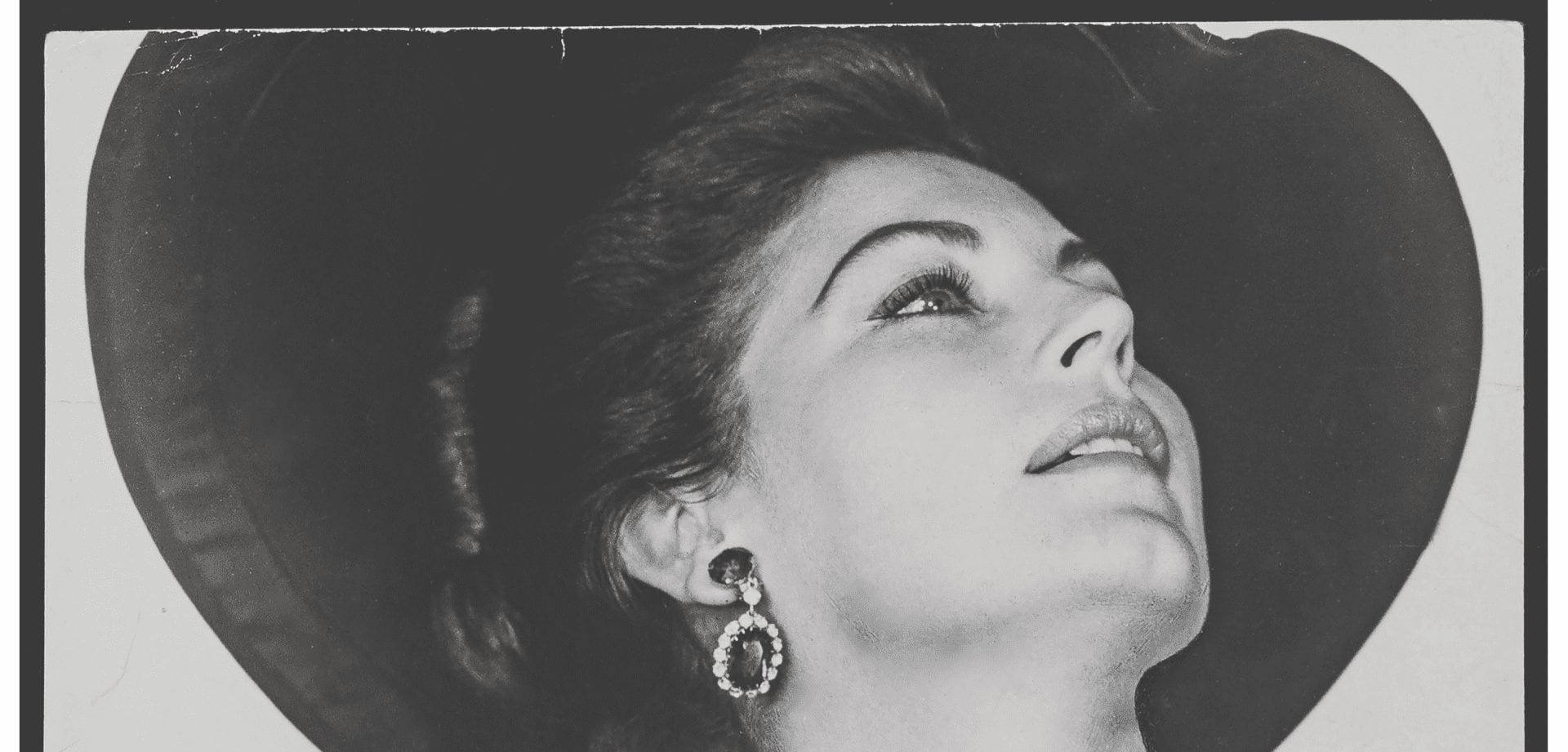Plucked from poverty with no education, Ava Gardner enchanted Hollywood for decades with her beauty and sophistication.
![]() WHO WAS AVA GARDNER? Some would say she was the most beautiful creature God had ever created. Even as a teenager, so sophisticated were her looks that in film, she would portray duchesses, baronesses, and gentry opposite the greatest leading men of the day: as Guinevere in Knights of the Round Table (1953) opposite Robert Taylor; Venus, the Goddess of Love, in One Touch of Venus (1948) opposite Robert Walker; Pandora in Pandora and the Flying Dutchman (1951) opposite James Mason; and as Maria Vargas in The Barefoot Contessa (1954) opposite Humphrey Bogart. Even legendary director John Ford, who she considered “the meanest man on earth and thoroughly evil,” who directed her in Mogambo was smitten by her beauty. It was Ford, she acknowledged, who brought out the best in her as an actress and she came to adore him. Countless men adored Ava, and Ava adored men. Her greatest friendships were with men. As for female friends, she had few and took only two into her confidence—her sister, Bappie, and her longtime maid and companion, Mearene Jordan, a black woman who Ava loved like a sister. Despite her thick Southern accent and utter lack of experience as an actress, Ava, at 17, was signed by MGM as a Hollywood contract player in 1941 on the merit of her incomparable beauty alone. She became a movie queen, was heralded as one of the most beautiful women in the world, inundated with priceless gifts from her three husbands and a multitude of lovers, and swarmed by adulating crowds. Yet the loneliness that pervaded throughout her childhood, and ripened with her hourglass figure, haunted Ava until she died on January 25, 1990, at the age of 67.
WHO WAS AVA GARDNER? Some would say she was the most beautiful creature God had ever created. Even as a teenager, so sophisticated were her looks that in film, she would portray duchesses, baronesses, and gentry opposite the greatest leading men of the day: as Guinevere in Knights of the Round Table (1953) opposite Robert Taylor; Venus, the Goddess of Love, in One Touch of Venus (1948) opposite Robert Walker; Pandora in Pandora and the Flying Dutchman (1951) opposite James Mason; and as Maria Vargas in The Barefoot Contessa (1954) opposite Humphrey Bogart. Even legendary director John Ford, who she considered “the meanest man on earth and thoroughly evil,” who directed her in Mogambo was smitten by her beauty. It was Ford, she acknowledged, who brought out the best in her as an actress and she came to adore him. Countless men adored Ava, and Ava adored men. Her greatest friendships were with men. As for female friends, she had few and took only two into her confidence—her sister, Bappie, and her longtime maid and companion, Mearene Jordan, a black woman who Ava loved like a sister. Despite her thick Southern accent and utter lack of experience as an actress, Ava, at 17, was signed by MGM as a Hollywood contract player in 1941 on the merit of her incomparable beauty alone. She became a movie queen, was heralded as one of the most beautiful women in the world, inundated with priceless gifts from her three husbands and a multitude of lovers, and swarmed by adulating crowds. Yet the loneliness that pervaded throughout her childhood, and ripened with her hourglass figure, haunted Ava until she died on January 25, 1990, at the age of 67.
AVA LAVINIA GARDNER was born in Grabstown, North Carolina, a one-road, unincorporated town in rural Johnston County that was so small, if you blinked driving through, you’d miss it. Her mother, Mary Elizabeth “Molly” Gardner, a warm, loving, devout Baptist woman of Scottish descent, was 39 years old when Ava, her seventh and last child, was born on Christmas Eve in 1922.
“It appeared that there was this whole other person, Jesus Christ, whose birthday a lot of people tended to confuse with mine,” Ava wrote in her autobiography, Ava, My Life, published posthumously at her direction, in 1990. “I was personally outraged. It was a long time before I forgave the Lord for that.” Her father, Jonas Baily Gardner, was a solemn, hardworking sharecropper and tobacco farmer who struggled to keep his large family clothed and fed.
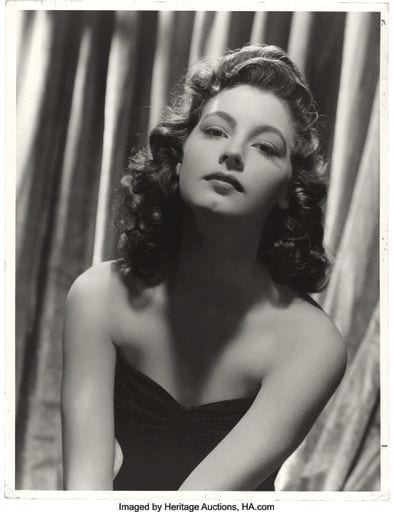 “When you are dirt poor,” Ava reflected many years later, “and there is no way of concealing it, life is hell.”
“When you are dirt poor,” Ava reflected many years later, “and there is no way of concealing it, life is hell.”
At first, the child believed the candlelit tree decorated with homemade ornaments, and the many relatives who came for Christmas dinner were celebrating her birthday, not His. Her mother, whom she adored almost as much as she did her father, baked two special cakes—one chocolate, the other coconut—because “Mama understood how lonely just one present for Christmas and your birthday could be.”
It was her father, a strong, quiet man, who laid down the law of the household. Jonas Gardner called his four other daughters by their Christian names but always called Ava, his favorite, “Daughter.” She favored him in appearance. He was tall, lean, with soft, wavy black hair, a cleft chin, and the green, sparkling eyes, which she inherited. From the time she could walk, Ava worked alongside her father in the tobacco fields. Years later, she could relate in great detail how tobacco was planted, harvested, and dried; the many hours she spent working in the fields, and the many nights she stayed up with her father to make sure the proper temperature in the tobacco barn was maintained to flue-cure the leaves. Except for school and church, she went barefoot to save wear and tear on her one pair of shoes. All her life, being barefoot was one of her greatest pleasures. Feeling the warm earth between her toes brought her back to her happy childhood. Indeed, those early days would be the happiest period in her tumultuous, colorful, spectacular, too-short life. Her youthful rage against the Lord was fueled by one tragedy after another—not the least of which was the loss of both her parents by the time she was 20.
“God didn’t take care of anything,” she remarked bitterly at the end of her life. “I hated religion.”
AVA WAS VISITING HER FAVORITE SISTER, Bappie, and her husband, Larry Tar, a professional photographer, in New York City when Larry asked his sister-in-law to sit for him. Though only 17, she had a timeless elegance about her. Tar was so pleased with the results that he displayed the photographs in the front window of his Fifth Avenue studio. Soon after, a representative of Loews Theaters, which was then was owned by MGM, saw the photographs and reached out to the studio’s talent scouts. A screen test in New York was arranged for Ava; however, when she opened her mouth, the director ordered the cameraman to stop rolling. Her North Carolina accent was so thick, no one could understand her. The director simply had Ava walk across the room and arrange some flowers in a vase on a table. When MGM boss Louis B. Mayer saw her screen test, he exclaimed, “She can’t sing, she can’t act, she can’t talk, she’s terrific!” and Ava was offered a standard seven-year contract.
Ava was too young to go alone to Hollywood, and her mother, who was suffering from cancer, was too ill to travel. So Bappie, whose marriage was on the rocks, accompanied her as a chaperone. One of the first things MGM was determined to do was to get rid of Ava’s North Carolina drawl.
“I was sent to Gertrude Vogeler, the voice coach, a woman I came to love very dearly. She was a beautiful old lady, very old, very gray-haired, very overweight, with a million cats—well, it seemed like a million anyway—and an ancient Chinese cook who was funnier than anything ever seen in the movies. Gertrude worked out of her own house on Whittier Drive. She had a hard time with me, but she was so loving and skillful. I can remember her sitting opposite me, her motherly bosom going up and down, trying to get my voice a couple of octaves closer to my navel. ‘Sit on it, Ava,’ she said. ‘Sit on it my, beauty! Make your voice come up from down there—down there. That’s good, that’s good!’ Gertrude had the most beautiful voice herself. And she was not just a voice coach, she was an institution. You’d go back to the cottage, and by God, you’d find you were into yoga exercises and breathing and all kinds of stuff. You were not going to breathe just from the throat, you were going to speak from down there—down there. Every time I went back to Los Angeles for years after that—as I’m sure so many other of her pupils did—I went back to kiss her on the cheek and say thank you.”
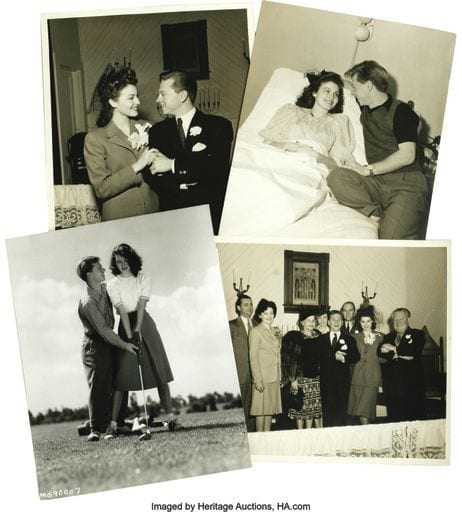
Gardner with her first husband, Mickey Rooney, at their wedding and on the golf course together. While Rooney taught Ava how to play golf, he also spent more time on the golf course than with her during their honeymoon, much to her dismay. COURTESY HERITAGE AUCTIONS/HA.COM / FROM THE AVA GARDNER ESTATE
Shortly after Ava separated from her first husband, Mickey Rooney, she met Howard Hughes. “What can I say about Howard Hughes?” she wrote. “A world-famous aviator, a multi-multi-millionaire, a very complex man, courageous, bold, and inventive? You bet. But also, painfully shy, completely enigmatic, and more eccentric, honey, than anyone I ever met. I was never in love with him, but he was in and out of my life for something like 20 very remarkable years.”
He made his intentions clear on their first date—and so did she. “Let me emphasize,” she explained, “that friend is the word for our relationship. Howard didn’t make any extravagant passes, in fact, made no demands on me at all. A kiss on the cheek after about our tenth dinner was as far as he went. He made it clear that he was interested in me emotionally and romantically, but he was prepared to be very patient. For my part, sharing a bed with him was always one length I couldn’t imagine myself going to.”
But she liked him immediately and within a week of their first dinner together, they became fast friends. “He was a straightforward, non-bull Texan, direct and terribly helpful in practically every way you can imagine” and all through the years “he continued to make things easy for me when I wanted things easy,” said the woman who never got over her hardscrabble childhood. However, their relationship—as with all Ava’s important relationships—soon became stormy and fraught with drama. It never boiled down to poor choices or bad luck. As a tomboy growing up, no water tower was too high to scale, no boy too tough to beat up, and no threat too threatening to face. She gave every bit of what she got, and that’s how she dealt with Howard. He would always appear before, during, and after Ava’s two subsequent marriages and countless romances, taking measures to thwart the advances of other men and filled with burning, unrequited hope of finally winning her over. She was, he thought, the loveliest creature God had ever made—and countless people felt the same way about her, too. He was determined to own her, and he had all the money in the world to buy her. But Ava couldn’t be bought. Many were the times she threw a priceless piece of jewelry at him in a rage or tossed a heavy, solid gold necklace parure out a hotel window. There was nothing she could do to keep him out of her life—and she liked it that way.
“When Howard Hughes wanted something, he went after it with tunnel vision, and he saw no reason not to use the same tactics on the gentlemanly seduction of me. He was, someone once said, like a spoiled child when he couldn’t get what he wanted, whining and wailing about it until he did. He could also be determinedly vengeful if anyone crossed or opposed him.”
In one particularly dramatic incident, Ava tells of the night she awoke in bed, alone, finding a wildly jealous Hughes hovering over her, in the dark, believing Mickey, from whom she was now divorced, was still sleeping with her. Rather than apologize, he pinned her down and began hitting her across the face with an open hand until her eye was swollen shut. Fearing for her life, she groped for something, anything, and felt the handle of a heavy, bronze, ornamental bell. She threw it at him, splitting his face open from his temple to his mouth. She ended up with a black eye and he ended up in the hospital.
And so, they continued to play at their cat-and-mouse games for the next two decades. “The saga of him and me was going to be one hell of a long-running serial,” she sighed.
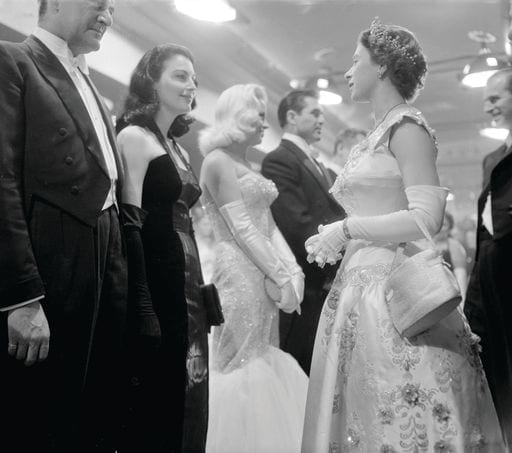
Gardner with the Queen during a Royal Command Film Performance, October 1955. TRINITY MIRROR / MIRRORPIX
EVEN WHEN SHE WAS MRS. MICKEY ROONEY, Ava failed to achieve a breakthrough into a major role, and she continued to act in small parts until 1946 when she finally won the female lead as the deadly seductress Kitty Carlson in the film adaptation of Ernest Hemingway’s short story, The Killers, first published in Scribner’s in 1927. Her co-star was Burt Lancaster in his first major motion picture role. So powerful was their on-screen presence together that if you lit a match, the air between them would combust. “Burt had all the confidence in the world. He’d never been in a movie before, but he seemed competent enough to take the whole thing over, and if Robert (Siodmak) hadn’t been such a strong director, he might have.” The biggest takeaway for Ava from The Killers was the lifelong friendship with her “chum,” “Papa” Hemingway. The Killers launched Ava as a star in post-World War II cinema, a time when Greta Garbo, Norma Sherer, and Irene Dunne’s stars were waning, and age forced Joan Crawford, Bette Davis, Katherine Hepburn, and Marlene Dietrich to reinvent themselves. But it wasn’t until 1947, six years after landing in Hollywood, that she really established herself, starring opposite her childhood idol, heartthrob, Clark Gable, in The Hucksters. Petrified to act opposite the Rhett Butler of her, and every young girl’s dreams, she was astonished to find him more handsome, more magnetic, and much more approachable than you’d expect of the King of Hollywood. Indeed, Gable was one of the kindest men Ava had ever met. Still deeply mourning the tragic loss four years before of his beloved wife and great love of his life, one of Hollywood’s brightest and most beautiful comedic actresses, Carole Lombard, in a plane crash, Gable became a paternal figure for Ava and took quiet measures to bolster the shy, insecure actress who, all her life, believed she had no talent. “Hey, kid,” he’d say quietly when it was clear Ava had lost her place during rehearsal. “You stuck? Let me give you a lead.”
“He was always trying to calm me down, always telling me, ‘You don’t see yourself as an actress and I don’t see myself as an actor. That’s what makes us even,’” Ava fondly recalled.
Gable’s contracts stipulated he would leave the set punctually at five o’clock, even if the cameras were still rolling. It was long after five when Clark, and all the important actors in the film, had left the set of The Hucksters when director Jack Conway was ready to film Ava’s big nightclub act.
Fearing she’d blow her biggest solo scene in the film, they were about to start when “I saw this handsome man carrying an old wooden kitchen chair onto the dance floor. He placed the chair right in front of me, reversed it, and sat down with his arms folded across the back. It was Clark Gable, grinning at me to begin. For God’s sake, how could I help but adore the man? There was never anything between us—ever. He’d lost his heart and almost the sense in his life when Carole Lombard was killed in that plane crash. I never met Carole, but Clark told me that at times her language had the same— shall I say—forthrightness as mine. When The Hucksters finally came out, I received some of the best notices of my career.”
IN 1945, AVA’S CLOSE FRIEND, Frances Heflin, the wife of actor Van Heflin, introduced Ava to the man who would become her second husband—jazz bandleader, composer, clarinetist Artie Shaw, who was famous for his version of Cole Porter’s “Begin the Beguine.” Fifteen years her senior and recently divorced from Ava’s good friend, Lana Turner, Ava and Shaw were inseparable from the first time they met.
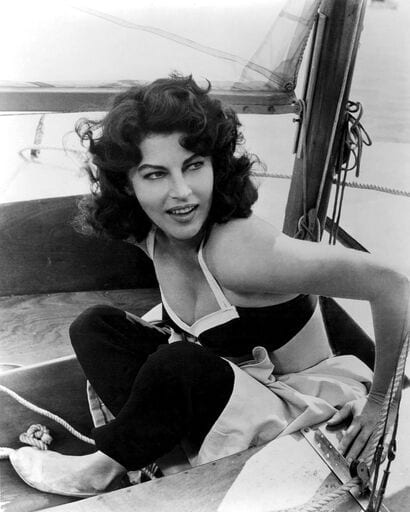
Gardner went from a young girl growing up on a tobacco farm to an international film star, though she still sought out activities that reminded her of her rural upbringing. CINECLASSICO
“Ava, I think that physically, emotionally, and mentally you are the most perfect woman I’ve ever met, and what’s more, I’d marry you tonight, except for the fact that I’ve married too many wives already,” Shaw said. That didn’t stop Ava from becoming the fourth of what would be Shaw’s eight marriages. From the moment they wed on October 17, 1945, until their divorce, Shaw was determined to improve the woman he had deemed “perfect,” insisting she read Sinclair Lewis, Dostoyevsky, and Thomas Mann, learn about politics and psychology, introducing her to music and art. Catching her one day reading the bestselling period romance, Forever Amber, Shaw took the book from her hands and flung it across the room. “If I’m in charge of your education,” he reprimanded, “you’re not going to read rubbish like that!”
He demeaned her, lowering Ava’s already low self-esteem to new depths. She saw a psychiatrist and took an IQ test, scoring surprisingly high. Intent on improving herself, she took literature and economics classes at UCLA. Shaw, a devoted chess player, hired a Russian grandmaster to teach her the game. The first time Ava played Shaw, she beat him—in less than 15 minutes. It was the only time they ever played chess together. The one-upmanship, the ever-flowing booze, the disparate personalities, and family backgrounds, and their frenetic Hollywood lifestyle battered their marriage. One year and one day after they vowed “I do,” Ava Gardner and Artie Shaw were divorced.
“THE FIRST TIME I MET FRANK SINATRA, I was still married to Mickey Rooney. We were out at some Sunset Strip club, probably Mocambo, and Frank was there. He knew Mickey pretty well—who didn’t—and he stepped across to meet the new wife. And being Frank, he did the big grin and said, ‘Hey, why didn’t I meet you before Mickey? Then I could have married you myself.’ That caught me off guard. I guess I smiled back uncertainly, but I don’t think I said a word. Because in those early days, I was always feeling out of my depth. Even to meet Frank Sinatra was exciting enough. To have him say a thing like that left me dumbfounded.”
In October 1951, a week after his long, drawn-out divorce from his first wife, Nancy, was final, Frank Sinatra married Ava. Her third, final, and longest marriage only lasted six years. He was the love of her life, but their relationship was ill-fated from the start. Sinatra was accused of being snatched from his wife, Nancy, by the seductress, Ava, and their subsequent marriage was condemned by the Catholic Church. Their work kept them apart more than together and as her star rose, his career plummeted.
In 1952, Ava starred in the second of three adaptations of Ernest Hemingway’s works, The Snows of Kilimanjaro, when producer Darryl F. Zanuck cast her as Cynthia opposite Gregory Peck, and the third and last, The Sun Also Rises, where Ava played Lady Brett Ashley with three of the silver screen’s most popular leading men, Tyrone Power, Mel Ferrer, and Errol Flynn. Once, when Ava stayed with Hemingway at his villa in Cuba, she swam in the nude in his pool. “Papa” ordered the pool water was never to be emptied.
Ava and Sinatra’s marriage had been tumultuous from the start, but the death knell sounded when Gardner became pregnant not once, but twice, within the span of a year. She made the decision to abort the first pregnancy, which she discovered while filming Mogambo in Africa, without consulting him. Nor did she consult him when she went through with the second abortion. “I think Frank, in his heart, knew what I was going to do, but it was my decision, not his. As long as I live, I’ll never forget waking up after the operation and seeing Frank sitting next to the bed with tears in his eyes. But I think I was right. I still think I was right.” The jealousies, the rages, the endless drunken nights, and the drama was simply too much for Sinatra.
“Though our love was deep and true, even though the fact that we couldn’t live with each other any more than we could have lived without each other sometimes made it hard for outsiders to understand. All I know is that if Frank had lost me or I’d lost him, our worlds would have been shattered.”
They divorced on June 5, 1957—and indeed, both their worlds were shattered. IN 1963, AVA STARRED WITH RICHARD BURTON in The Night of the Iguana, directed by John Huston. Though she had never met him, she knew his wife. “Elizabeth (Taylor) and I were friends from the old Metro days. It’s like we were two graduates from the same alma mater, pleased to find each other in the wilderness, and though this was the first time I’d met Richard, I felt the same way about him. He was like someone I would have liked to have had for a brother.” Like Ava, Burton and Elizabeth were ferocious drinkers. Except for the news of President John F. Kennedy’s assassination, the cast and crew worked cheerfully and cohesively to make a first-rate film out of Tennessee Williams’ play—and the reason was Huston.
“Dear John. I have only one rule in acting—trust the director and give him heart and soul. And the director I trusted most of all was John Huston. Working with him gave me the only real joy I’ve ever had in movies.”
In 1966, she was reunited with director John Huston when he again cast Ava in one of his films, this time as Sarah, wife of Abraham, in the Dino de Laurentiis spectacular The Bible…in the Beginning. It was, perhaps, the most unusual film in the repertoire of a woman who had spurned God. “Huston had more faith in me than I did myself,” she would comment. “Now I’m glad I listened, for it is a challenging role and a very demanding one. I started out as a young wife in age through various periods, forcing me to adjust psychologically to each age. It is a complete departure for me and most intriguing.”
Her co-star was George C. Scott as Abraham. The two fiery personalities ignited instantly, and Ava entered into perhaps the most passionately explosive relationship in her life. “To make a long story short, I fell for George and he fell for me in those early weeks of shooting. George seemed highly intelligent and civilized, very gentle. So, what was the problem? The problem, honey, was booze. We both drank a fair amount, but when I drank, I usually got mellow and happy. When George got drunk, he could go berserk in a way that was quite terrifying.”
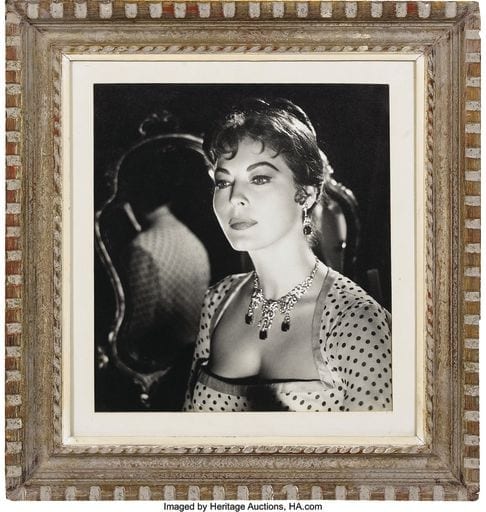
Still from The Naked Maja (MGM, 1958), directed by Henry Koster, starring Ava Gardner and Anthony Franciosa. COURTESY HERITAGE AUCTIONS/HA.COM / FROM THE AVA GARDNER ESTATE
Ava recounted an episode where she and George “had gone out to dinner, and returning to the hotel, we’d gone back to his room for a nightcap. George had drunk quite a lot that night, and after another two or three, I could see he was getting into one of his rages. He began to argue with me, and I decided it was time to leave. Fat chance. Suddenly, out of the blue, his hand smashed across my face and punches fell on me from all angles. It felt like hours before I managed to get out. The next morning, I took my swollen bruised face and black eye to the makeup man. God, I was a mess. He took one looked at me and screamed, ‘For Christ’s sake, who did this to you?’ I didn’t tell him, but it wasn’t too hard to figure out.”
IN 1968, AVA UNDERWENT an elective hysterectomy in London to prevent any chance of contracting cancer, which took the life of her mother. She continued to act until 1986. The woman who all her life believed she could not act and saw her success as a film star as “really quite a joke” is listed 25th among the American Film Institute’s “25 greatest female stars of the classic Hollywood cinema.” In 1951, Ava was nominated for a Picturegoers Gold Medal for best actress in Pandora and the Flying Dutchman. In 1953, she was nominated for Best Actress by the New York Film Critics Circle for Mogambo, and also for an Oscar for Best Actress in a Leading Role.
She was nominated for a BAFTA for Best Foreign Actress in Bhowani Junction in 1958, a Golden Laurel for Top Female Star of 1960, and that same year received a star on the Hollywood Walk of Fame. Again, she was nominated for a BAFTA for Best Foreign Actress for On the Beach in 1964. In 1965, she was nominated for a Golden Globe and a BAFTA for Night of the Iguana and won the Best Actress award at the San Sebastian International Film Festival. Her range was limitless. Not only did she star in dramas, but famously, in 1951, in the smash musical film version of Show Boat as Julie Laverne, and in 1953 she starred with Fred Astair and Cyd Charisse in The Bandwagon. She appeared in 53 films alongside celebrated actors, other than those mentioned, including Adolophe Menjou, Agnes Moorehead, Ann Rutherford, Ann Sothern, Anthony Franciosa, Anthony Perkins, Anthony Quinn, Barbara Stanwyck, Beulah Bondi, Broderick Crawford, Burgess Meredith, Catherine Deneuve, Charles Laughton, Charlton Heston, Cicely Tyson, Cyril Cusack, David Niven, Deborah Kerr, Dirk Bogarde, Edmund Gwenn, Edward Arnold, Ethel Barrymore, Eve Arden, Flora Robson, Franchot Tone, Franco Nero, Frank Morgan, Fred MacMurray, Fredric March, Gene Kelly, George Kennedy, George Raft, Grace Kelly, Gregory Peck, Henry Fonda, Howard Keel, Ian McShane, Jacqueline Bisset, Joe E. Brown, John Carradine, Joseph Cotton, Kathryn Grayson, Keenan Wynn, Kirk Douglas, Lena Horne, Leo G. Carroll, Leslie Nielsen, Lionel Barrymore, Lorne Green, Margaret O’Brien, Mel Ferrer, Melvyn Douglas, Nanette Fabray, Norma Shearer, Omar Sharif, Oscar Levant, Paul Lukas, Paul Newman, Peter O’Toole, Reginald Owen, Richard Harris, Robert Mitchum, Robert Morely, Robert Young, Roddy McDowall, Rossano Brazzi, Shelley Winters, Sir John Gielgud, Sophia Loren, Stewart Granger, Susan Hayward, Sydney Greenstreet, Sylvia Miles, Tab Hunter, Van Heflin, Van Johnson, Victor McLaglen, and Vincent Price.
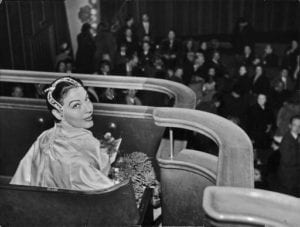
Gardner at The Barefoot Contessa premiere in Stockholm, Sweden, 1954. TRINITY MIRROR / MIRRORPIX /
When, at the end of her life, she was asked about her faith, she pledged she had none. Her disdain can be traced to the death of her father when she was 15. In her autobiography she wrote, “Nobody wanted to know Daddy when he was dying, and he was so alone, he was so scared, I could see the fear in his eyes when he was smiling, and I went to see the preacher, the guy who baptized me. I begged him to come and visit Daddy just to talk to him—you know, give a blessing or something—but he never came. God, I hated him! Cold bastards like that ought to, I don’t know, they should be in some other racket. I had no time for religion after that. I never prayed, I never said another prayer.”
Ava was a lifelong smoker and suffered from emphysema. In her 50s, she was diagnosed with an unidentified autoimmune disease, and in 1986, she suffered two debilitating strokes. Ava and Sinatra had remained close friends, speaking on the phone every day. He succeeded in reinventing himself in the early ’50s as a dramatic actor, revived his singing career in the ’60s, and gained universal notoriety as the leader of the Rat Pack. His fortunes reinstated, he arranged for a medically staffed private plane to fly Ava from London, where she lived, back to America for medical treatment. However, shortly after her return back home to London, she suffered a bad fall in her flat. She died shortly after of pneumonia at her London home of many years, 434 Ennismore Gardens, where she had lived since 1968. Her final words were, “I’m so tired.”
Ava returned to where she came from, near Grabtown, where she is buried at Sunset Memorial Park in Smithfield, North Carolina, next to her siblings and her parents. The Ava Gardner Museum is located at 325 East Market Street, Smithfield, North Carolina.
Ava Gardner lived life to the hilt. And yet, of all the regrets she may have had, one stands out above all others: “If I could ever be born again, an education is what I’d want. My life would have been so different if I’d had one.”
Excerpts and quotes from AVA:MY STORY were used with the permission of the publisher.
By Laurie Bogart Wiles
Author’s Note: My mother wrote her own eulogy, which was read at her funeral to a congregation of over 500 mourners. It began, “Who knows me better than me?” Even though I have read, and watched, miles of film footage and read reams of paper on Ava Gardner to prepare this biography, who, indeed, knew her better than she? For that reason, the quotes I have included are taken from her book, Ava, My Story, published posthumously by Bantam Books in November 1990.

